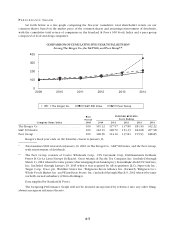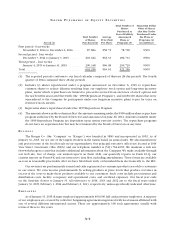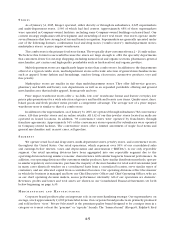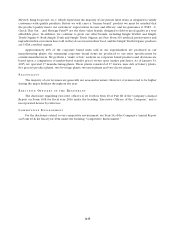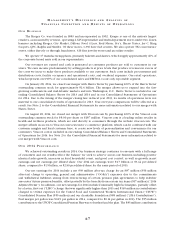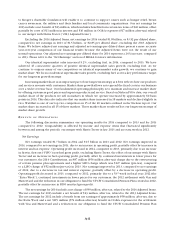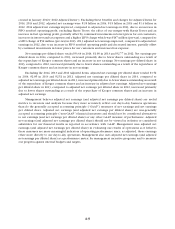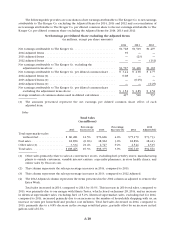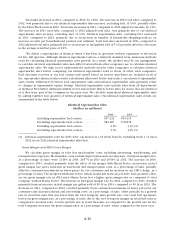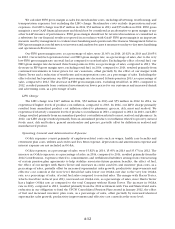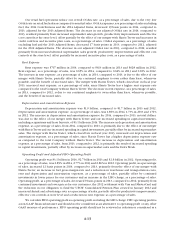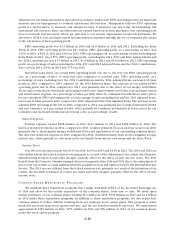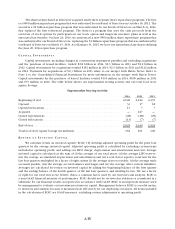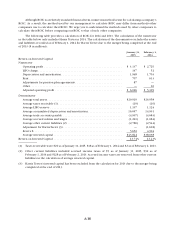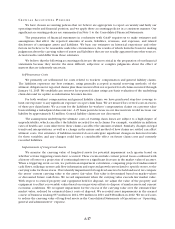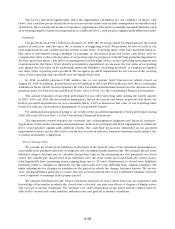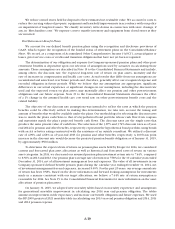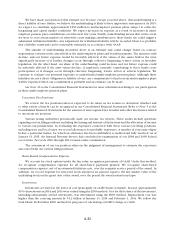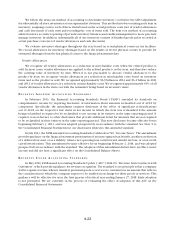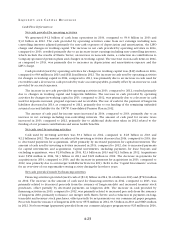Kroger 2014 Annual Report Download - page 78
Download and view the complete annual report
Please find page 78 of the 2014 Kroger annual report below. You can navigate through the pages in the report by either clicking on the pages listed below, or by using the keyword search tool below to find specific information within the annual report.A-13
Our retail fuel operations reduce our overall OG&A rate, as a percentage of sales, due to the very low
OG&A rate on retail fuel sales as compared to non-fuel sales. OG&A expenses, as a percentage of sales excluding
fuel, the 2014 Contributions and the 2014 Adjusted Items, decreased 19 basis points in 2014, compared to
2013, adjusted for the 2013 Adjusted Items. The decrease in our adjusted OG&A rate in 2014, compared to
2013, resulted primarily from increased supermarket sales growth, productivity improvements and effective
cost controls at the store level, offset partially by the effect of our merger with Harris Teeter and increases in
credit card fees and incentive plan costs, as a percentage of sales. OG&A expenses, as a percentage of sales
excluding fuel and the 2013 Adjusted Items, decreased 17 basis points in 2013, compared to 2012, adjusted
for the 2012 Adjusted Items. The decrease in our adjusted OG&A rate in 2013, compared to 2012, resulted
primarily from increased identical supermarket sales growth, productivity improvements and effective cost
controls at the store level, offset partially by increased incentive plan costs, as a percentage of sales.
Rent Expense
Rent expense was $707 million in 2014, compared to $613 million in 2013 and $628 million in 2012.
Rent expense, as a percentage of sales, was 0.65% in 2014, compared to 0.62% in 2013 and 0.65% in 2012.
The increase in rent expense, as a percentage of sales, in 2014, compared to 2013, is due to the effect of our
merger with Harris Teeter, partially offset by our continued emphasis to own rather than lease, whenever
possible, and the benefit of increased sales. The merger with Harris Teeter, which closed late in fiscal year
2013, increased rent expense, as a percentage of sales, since Harris Teeter has a higher rent expense rate
compared to the total Company without Harris Teeter. The decrease in rent expense, as a percentage of sales,
in 2013, compared to 2012, is due to our continued emphasis to own rather than lease, whenever possible,
and the benefit of increased sales.
Depreciation and Amortization Expense
Depreciation and amortization expense was $1.9 billion, compared to $1.7 billion in 2013 and 2012.
Depreciation and amortization expense, as a percentage of sales, was 1.80% in 2014, 1.73% in 2013 and 1.71%
in 2012. The increase in depreciation and amortization expense for 2014, compared to 2013, in total dollars,
was due to the effect of our merger with Harris Teeter and our increased spending in capital investments,
including acquisitions and lease buyouts, of $3.1 billion in 2014. The increase in depreciation and amortization
expense, as a percentage of sales, from 2014, compared to 2013, is primarily due to the effect of our merger
with Harris Teeter and our increased spending in capital investments, partially offset by increased supermarket
sales. The merger with Harris Teeter, which closed late in fiscal year 2013, increased our depreciation and
amortization expense, as a percentage of sales, since Harris Teeter has a higher depreciation expense rate
as compared to the total Company without Harris Teeter. The increase in depreciation and amortization
expense, as a percentage of sales, from 2013, compared to 2012, is primarily the result of increased spending
in capital investments, partially offset by increases in supermarket sales and the Extra Week.
Operating Profit and Adjusted FIFO Operating Profit
Operating profit was $3.1 billion in 2014, $2.7 billion in 2013 and $2.8 billion in 2012. Operating profit,
as a percentage of sales, was 2.89% in 2014, 2.77% in 2013 and 2.86% in 2012. Operating profit, as a percentage
of sales, increased 12 basis points in 2014, compared to 2013, primarily from the effect of our merger with
Harris Teeter, an increase in fuel gross margin rate and a reduction in warehouse and transportation costs,
rent and depreciation and amortization expenses, as a percentage of sales, partially offset by continued
investments in lower prices for our customers and an increase in the LIFO charge, as a percentage of sales.
Operating profit, as a percentage of sales, decreased 9 basis points in 2013, compared to 2012, primarily from
continued investments in lower prices for our customers, the 2012 settlement with Visa and MasterCard and
the reduction in our obligation to fund the UFCW Consolidated Pension Plan created in January 2012 and
increased shrink and advertising costs, as a percentage of sales, partially offset by productivity improvements,
effective cost controls at store level and a reduction in rent expense, as a percentage of sales.
We calculate FIFO operating profit as operating profit excluding the LIFO charge. FIFO operating profit is
a non-GAAP financial measure and should not be considered as an alternative to operating profit or any other
GAAP measure of performance. FIFO operating profit should not be reviewed in isolation or considered as a


